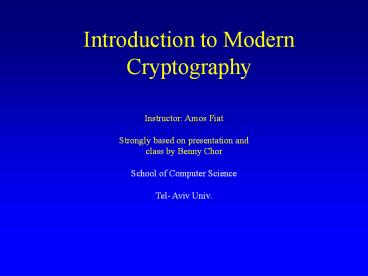Introduction%20to%20Modern%20Cryptography PowerPoint PPT Presentation
Title: Introduction%20to%20Modern%20Cryptography
1
Introduction to Modern Cryptography
Instructor Amos Fiat Strongly based on
presentation and class by Benny Chor School of
Computer Science Tel- Aviv Univ.
2
Administrative Details
- Grade exam (75 ), homework (25 ).
- Exam on last class. In class exam. No 2nd chance.
- Homework submission in pairs.
- 2-3 dry assignments.
- 1-2 wet assignments (in MAPLE).
- Office hours By e-appointment.
- E-mail fiat_at_cs.tau.ac.il
3
Course Outline
- Encryption
- Data integrity
- Authentication and identification
- Digital signatures
- Number theory
- Randomness and pseudo-randomness
- Cryptographic protocols
- Real world security systems
- Watermarking, digital rights management, etc.
4
Prerequisites
Linear Algebra Probability Computational
Models Mathematical Maturity
5
Bibliography
- Text Book
- Cryptography Theory and Practice,
- D. Stinson, CRC Press, 1996.
- (should be available at the
- library)
- Recommended
- - Handbook of Applied Cryptography
- Menezes, Van Oorschot, Vanstone
- (free download at
- http//www.cacr.math.uwaterloo.ca/hac
) - - Applied Cryptography, B. Schneier
6
Good Crypto Courses on the Web
- Hugo Krawczyk course at the Technion.
- Ron Rivest course at MIT.
- Dan Boneh course at Stanford.
- Phil Rogaway Course at UC Davis.
- Eli Biham course at the Technion.
- Doug Stinson course at Waterloo.
7
Encryption
- Much of Security has little to do with Encryption
- Encryption deals with secrecy
- Most real security deals with problems of fraud
- Message modifications
- Almost invariably, Encryption does not live
alone without some form of authentication
8
Definitions
- Encryption function ( algorithm) E
- Decryption function ( algorithm) D
- Encryption key k1
- Decryption key k2
- Message space (usually binary strings)
- For every message m D k2(E k1 (m)) m
9
Communication Model
Alice
Bob
- Two parties Alice and Bob
- Reliable communication line
- Shared encryption scheme E, D, k1, k2
- Goal send a message m confidentially
10
Threat Model
Alice
Bob
Eve
- 4. Goal send a message m confidentially
11
Security Goals
- Possibilities
- No adversary can determine m
- No adversary can determine any information about
m - No adversary can determine any meaningful
information about m.
12
Adversarial model
- Eve attempts to discover information about m
- Eve knows the algorithms E,D
- Eve knows the message space
- Eve has at least partial information about Ek1(m)
- Eve does not know k1, k2
13
Examples bad ciphers
- Shift cipher
- Conclusion large key space required
- Substitution cipher
- Large key space, still easy to break
14
Substitution cipher
- Example
- plaintext attack at dawn
- ciphertext waaoq wa vwmk
Size of key space 26!403291461126605635584000000
4 x 1028
large enough
15
Additional definitions
- Plaintext the message prior to encryption
- (attack at dawn, sell MSFT at 57.5)
- Ciphertext the message after encryption
- (????? ??????????,jhhfoghjklvhgbljhg )
- Symmetric key encryption scheme where k1k2
- (classical cryptography)
16
Perfect Cipher
- Plaintext space 0,1n
- Given a ciphertext C the probability that
Dk2(C)P for any plaintext P is equal to the
apriori probability that P is the plaintext. - In other words
- PrplaintextPC PrplaintextP
- Probabilities are over the key space and
- the plaintext space.
17
Example One Time Pad
- Plaintext space - 0,1n
- Key space - 0,1n
- The scheme is symmetric, key k is chosen at
random - Ek(P) C P ? K
- Dk(C) C ? K P
18
Pros and Cons
- Claim the one time pad is a perfect cipher.
- Problem size of key space.
- Theorem (Shannon) A cipher cannot be perfect if
its key space is less than the size of its
message space. - Why??? Argue in class.
19
Computational Power
- Time
- Hardware
- Storage
- Theoretical polynomial time
- Practical 264 is feasible, 280 is infeasible
20
Attack Models
- Eavesdropping
- Known plaintext
- Chosen plaintext
- Chosen ciphertext
- Adaptive chosen text attacks
- Physical access
- Physical modification of messages

